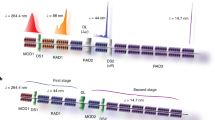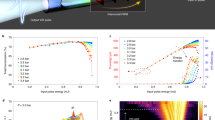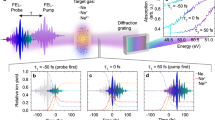Abstract
Continuing efforts in ultrashort pulse engineering have recently led to the breakthroughs of the generation of attosecond (10−18 s) pulse trains1,2,3,4,5,6,7 and isolated pulses8,9,10,11. Although trains of multiple pulses can be generated through the interaction of many-optical-cycle pulses with gases—a process that has led to intense extreme-ultraviolet emission3,4,5—the generation of isolated high-intensity pulses, which requires few-cycle driving pulses, remains a challenge. Here, we report a vital step towards the generation of such pulses, the production of broad continuum extreme-ultraviolet emission using a high-intensity, many-cycle, infrared pulsed laser, through the interferometric modulation of the ellipticity of 50-fs-long driving pulses. The increasing availability of high-power many-cycle lasers and their potential use in the construction of intense attosecond radiation—with either gas or solid-surface targets12—offer exciting opportunities for multiphoton extreme-ultraviolet-pump–extreme-ultraviolet-probe studies of laser–matter and laser–plasma interactions.
This is a preview of subscription content, access via your institution
Access options
Subscribe to this journal
Receive 12 print issues and online access
$259.00 per year
only $21.58 per issue
Buy this article
- Purchase on SpringerLink
- Instant access to full article PDF
Prices may be subject to local taxes which are calculated during checkout




Similar content being viewed by others
References
Hansch, T. W. A proposed sub-femtosecond pulse synthesizer using separate phase-locked laser oscillators. Opt. Commun. 80, 71–75 (1990).
Farkas, Gy. & Toth, Cs. Proposal for attosecond light pulse generation using laser induced multiple-harmonic conversion processes in rare gases. Phys. Rev. A 168, 447–450 (1992).
Tzallas, P. et al. Direct observation of attosecond light bunching. Nature 426, 267–271 (2003).
Nabekawa, Y. et al. Interferometric autocorrelation of an attosecond pulse train in the single-cycle regime. Phys. Rev. Lett. 97, 153904 (2006).
Nabekawa, Y. et al. Conclusive evidence of an attosecond pulse train observed with the mode-resolved autocorrelation technique. Phys. Rev. Lett. 96, 083901 (2005).
Paul, P. M. et al. Observation of train of attosecond pulses from high harmonic generation. Science 292, 1689–1692 (2001).
Mairesse, Y. et al. Attosecond synchronization of high-harmonic soft X-rays. Science 302, 1540–1543 (2003).
Hentschel, M. et al. Attosecond metrology. Nature 414, 509–513 (2002).
Kienberger, R. et al. Atomic transient recorder. Nature 427, 817–821 (2004).
Sansone, G. et al. Isolated single-cycle attosecond pulses. Science 314, 443–446 (2006).
Sola, I. J. et al. Controlling attosecond electron dynamics by phase-stabilized polarization gating. Nature Phys. 2, 319–322 (2006).
Baeva, T., Gordienko, S. & Pukhov, A. Relativistic plasma control for single attosecond x-ray burst generation. Phys. Rev. E 74, 065401(R) (2006).
Corkum, P. B. Plasma prospective on strong-field multiphoton ionization. Phys. Rev. Lett. 71, 1994–1997 (1993).
Lewenstein, M. et al. Theory of high harmonic generation by low-frequency laser fields. Phys. Rev. A 49, 2117–2132 (1994).
Kobayashi, Y. et al. 27-fs extreme ultraviolet pulse generation by high order harmonics. Opt. Lett. 23, 64–66 (1998).
Papadogiannis, N. A. et al. Two XUV-photon ionization of He through a superposition of higher harmonics. Phys. Rev. Lett. 90, 133902 (2003).
Nikolopoulos, L. A. A. et al. Second order autocorrelation of an XUV attosecond pulse train. Phys. Rev. Lett. 94, 113905 (2005).
Sekikawa, T. et al. Nonlinear optics in the extreme ultraviolet. Nature 432, 605–608 (2004).
Nabekawa, Y. et al. Production of doubly charged helium ions by two-photon absorption of an intense sub-10-fs soft X-ray pulse at 42 eV photon energy. Phys. Rev. Lett. 94, 043001 (2005).
Benis, E. P. et al. Frequency-resolved photoelectron spectra of two-photon ionization of He by an attosecond pulse train. New J. Phys. 8, 92 (2006).
Benis, E. P. et al. Two-photon double ionization of rare gases by a superposition of harmonics. Phys. Rev. A 74, 051402(R) (2006).
Miyamoto, N. et al. Observation of two-photon above-threshold ionization of rare gases by XUV harmonic photons. Phys. Rev. Lett. 93, 083903 (2004).
Corkum, P. B., Burnett, N. H. & Ivanov, M. Y. Subfemtosecond pulses. Opt. Lett. 19, 1870–1872 (1994).
Baltuska, A. et al. Attosecond control of electronic processes by intense light fields. Nature 421, 611–615 (2003).
Tcherbakoff, O. et al. Time-gated high-order harmonic generation. Phys. Rev. A 68, 043804 (2003).
Tsakiris, G. D. et al. Route to intense single attosecond pulses. New J. Phys. 8, 19 (2006).
Antoine, P., L’Huillier, A. & Lewenstein, M. Attosecond pulse trains using high-order harmonics. Phys. Rev. Lett. 77, 1234–1237 (1996).
Gaarde, M. B. & Schafer, K. J. Space-time considerations in the phase locking of high harmonics. Phys. Rev. Lett. 89, 213901 (2002).
Acknowledgements
This work is supported in part by the European Community’s Human Potential Program under contract MRTN-CT-2003-505138 (XTRA); MTKD-CT-2004-517145 (X-HOMES); the Ultraviolet Laser Facility (ULF) operating at FORTH-IESL (contract no. HPRI-CT-2001-00139) and the P14 COST programme.
Author information
Authors and Affiliations
Corresponding author
Rights and permissions
About this article
Cite this article
Tzallas, P., Skantzakis, E., Kalpouzos, C. et al. Generation of intense continuum extreme-ultraviolet radiation by many-cycle laser fields. Nature Phys 3, 846–850 (2007). https://doi.org/10.1038/nphys747
Received:
Accepted:
Published:
Issue date:
DOI: https://doi.org/10.1038/nphys747
This article is cited by
-
Experimental demonstration of attosecond pump–probe spectroscopy with an X-ray free-electron laser
Nature Photonics (2024)
-
Α 10-gigawatt attosecond source for non-linear XUV optics and XUV-pump-XUV-probe studies
Scientific Reports (2020)
-
Spectral interferometry with waveform-dependent relativistic high-order harmonics from plasma surfaces
Nature Communications (2018)
-
Quantum optical signatures in strong-field laser physics: Infrared photon counting in high-order-harmonic generation
Scientific Reports (2016)
-
Single-Shot Measurement of Temporally-Dependent Polarization State of Femtosecond Pulses by Angle-Multiplexed Spectral-Spatial Interferometry
Scientific Reports (2016)



